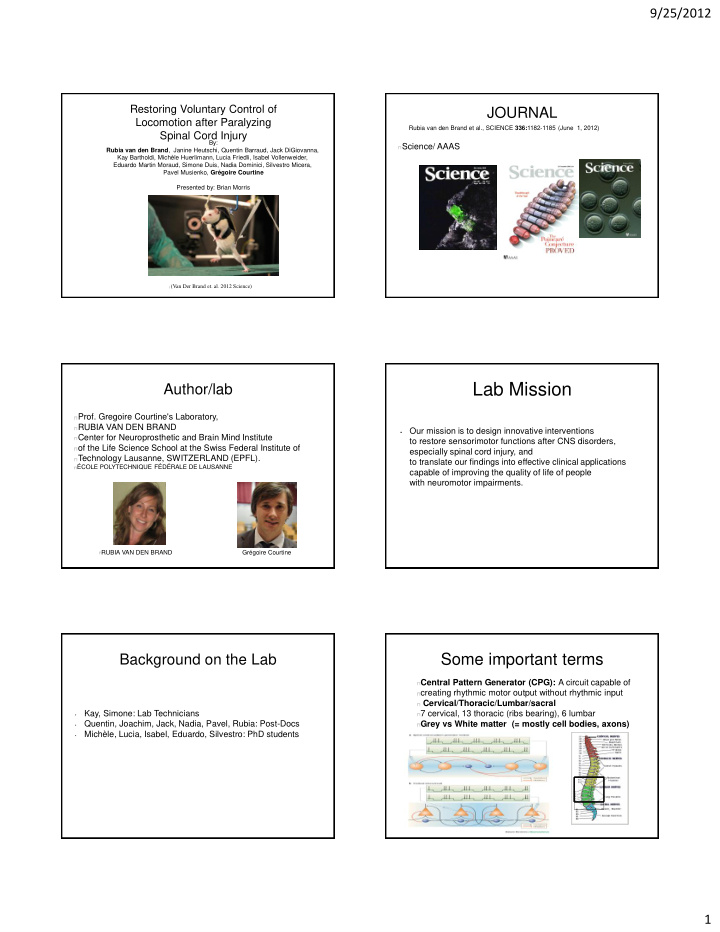



9/25/2012 Restoring Voluntary Control of JOURNAL Locomotion after Paralyzing Rubia van den Brand et al., SCIENCE 336: 1182-1185 (June 1, 2012) Spinal Cord Injury By: Science/ AAAS Rubia van den Brand , Janine Heutschi, Quentin Barraud, Jack DiGiovanna, Kay Bartholdi, Michèle Huerlimann, Lucia Friedli, Isabel Vollenweider, Eduardo Martin Moraud, Simone Duis, Nadia Dominici, Silvestro Micera, Pavel Musienko, Grégoire Courtine Presented by: Brian Morris (Van Der Brand et. al. 2012 Science) Lab Mission Author/lab Prof. Gregoire Courtine's Laboratory, RUBIA VAN DEN BRAND Our mission is to design innovative interventions Center for Neuroprosthetic and Brain Mind Institute to restore sensorimotor functions after CNS disorders, of the Life Science School at the Swiss Federal Institute of especially spinal cord injury, and Technology Lausanne, SWITZERLAND (EPFL). to translate our findings into effective clinical applications ÉCOLE POLYTECHNIQUE FÉDÉRALE DE LAUSANNE capable of improving the quality of life of people with neuromotor impairments. RUBIA VAN DEN BRAND Grégoire Courtine Some important terms Background on the Lab Central Pattern Generator (CPG): A circuit capable of creating rhythmic motor output without rhythmic input Cervical/Thoracic/Lumbar/sacral Kay, Simone: Lab Technicians 7 cervical, 13 thoracic (ribs bearing), 6 lumbar • Quentin, Joachim, Jack, Nadia, Pavel, Rubia: Post-Docs Grey vs White matter (= mostly cell bodies, axons) • Michèle, Lucia, Isabel, Eduardo, Silvestro: PhD students • 1
9/25/2012 Introduction Previous Research Transformation of nonfunctional spinal circuits into Activity based spinal motor output training functional states after the loss of brain input. (Courtine et al., 2008) - activation of cortical neurons Hypothesis: Re-establish supraspinal control of locomotion Previous work done on rats and zebrafish Electrical and chemical stimulation Mechanism for rehabilitation of circuits Over-ground trained vs treadmill studied in most cases, not well understood Results Methods http://www.sciencemag.org/content/suppl/2012/ Video 05/30/336.6085.1182.DC1.html Regain of function, automated vs. sensory ques Remodeling of circuits, and bypass of lesions Over ground vs treadmill Density of CST axons in each case Correlation between motor cortex and Cortical Spinal Tracts Cortex necessity Seratonergic inputs Figures Figures Figures contd. (B) Robotic postural interface providing vertical and lateral support, but no facilitation in the forward direction. Fig. 1.Multisystem neuroprosthetic training restores voluntary locomotion after paralyzing SCI. (A) Left hindlimb kinematics, hindlimb end-point trajectory and velocity vector, vertical ground reaction forces (vGRF), as well as electromyographic (EMG) activity of medial gastrocnemius (MG) and TA muscles during bipedal locomotion in an intact rat. 2
9/25/2012 (D) Distance covered in 3 min during bipedal locomotion.%, Body weight support. **P < 0.01. ***P < 0.001. Error bars, SEM (C) Representative left hindlimb stepping patterns recorded under the various experimental conditions 1 and 9 weeks post SCI. (F) Colocalization of FB and c-fos. Scale bar, 10 mm. (G) Overground-trained rats received a complete T6 SCI (n = 2) or T8/T9 NMDA microinjections (n = 3). (H) Distance covered in 3 min before and after the lesions. *P < 0.05. **P < 0.01. Error bars, SEM. Fig. 2. Multisystem neuroprosthetic training promotes the formation of intraspinal detours that relay supraspinal information. Diagram illustrating anatomical experiments. (B) Longitudinal and transverse views of three-dimensional (3D) reconstructions of Fast blue – labeled (FB) neurons between the lesions. L, left; R, right; Ro, rostral; C, caudal; D, dorsal; V, ventral. (C) Counts (n = 6 to 9 rats per group) of FB neurons in laminae 7 to 10 of T8/T9 segments after 45 min of continuous locomotion. (D) C-fos expression patterns in T8/T9 segments. (E) Counts (n = 5 to 7 rats per group) of c-fos ON neurons in laminae 7 to 10 after continuous locomotion. Fig. 4. Overground-trained rats regained cortical control of hindlimb locomotion. (A) Responses evoked by a train of epidural motor cortex stimulations in the left (B) TA muscle in a nontrained and overgroundtrained rat. (B) Mean (n = 5 rats per group) (C)amplitude of responses. 3
9/25/2012 Discussion Answers to questions Importance of remodeling: use dependent vs complete regeneration 1: (Answer in class) Define a Central Pattern Generator (CPG) Implications for future: robots or not in one sentence.: A circuit capable of creating rhythmic motor output without rhythmic input 2: Where were the lesions in the spinal cord made? Why were these locations chosen?: T7/T10, to eliminate supraspinal input without complete lesion 3: How did they stimulate the cord after injury?: Electrical stimulation (L2, S1) and a drug coctail of Seratonin agonists and Dopamine See also Video of Grégoire Courtine explaining References results of this paper / http://courtine-lab.epfl.ch/ Lab/author http://actu.epfl.ch/news/walking-again-after-spinal-cord-injury-2 Magazine http://www.sciencemag.org/search?author1=Gr%C3%A9goire+Courtine&sortspec=date&submit=Submit Prof Courtine: www.google.com/images CPG:http://www.nature.com/nrn/journal/v6/n6/images/nrn1686-f1.jpg Blue spinal cord injury picuture: http://blog.billhurst.com/lawyer-login-panel/wp-content/uploads/2011/03/spinal-cord.jpg Treadmill picture: http://www.rehabmed.emory.edu/pt/images/spinal_1.jpg Courtine et al., Nat. Med. 14, 69 (2008). Corticospinal tract (in red) Ventral view of cortico-spinal motor tract – Pyramidal tract and From Grey’s anatomy pyramidal decussation (caudal to the pons) Ventral (anterior) Dorsal 4
9/25/2012 Neuroanatomy - The Corticospinal Tract in 3D - YouTube www.youtube.com/watch?v=9BaWBGRVxp8Jul 19, 2009 - 3 min - Uploaded by BrainwashedSoftware Visit http://www.brainwashedsoftware.com for more information. This is the corticospinal tract as seen in Axiom ... http://www.youtube.com/watch?v=9BaWBGRV Cross section of spinal cord showing sensory bundles (in blue) and motor bundles in red. The lateral pyramidal tracts project to the limbs, the ventral (anterior) tracts project to the xp8 trunk. 5
Recommend
More recommend